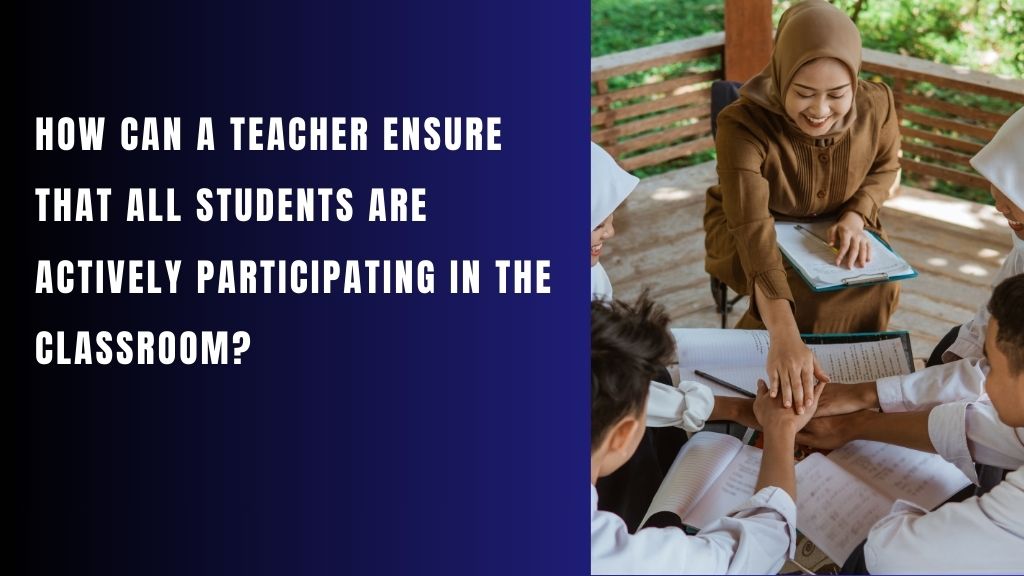Ensuring active participation in the classroom is a crucial aspect of effective teaching. Active participation fosters student engagement, enhances understanding, and creates an inclusive learning environment. But how can a teacher ensure that all students are actively participating in the classroom? With diverse learning styles and varying levels of confidence, it can be challenging to involve every student.
However, by implementing thoughtful strategies and encouraging interaction, teachers can cultivate a classroom where all students feel valued and motivated to contribute.
How Can a Teacher Ensure That All Students Are Actively Participating in the Classroom?
1. Create a Positive and Inclusive Environment
A welcoming classroom environment sets the foundation for student participation. Teachers can establish respectful relationships with students and encourage mutual respect among peers. Consider these tips:
- Greet students warmly and learn their names.
- Promote a growth mindset by celebrating effort and progress.
- Establish clear rules that encourage respectful discussions.
- Offer positive reinforcement for contributions, regardless of correctness.
An inclusive environment also involves creating opportunities for all students to participate, including those who are shy or reluctant. Provide low-pressure opportunities for input, such as written reflections or anonymous polling, which can build confidence over time.
2. Understand Different Learning Styles
Every student learns differently. Some may prefer visual aids, while others excel through hands-on activities. Teachers should incorporate a variety of teaching methods to meet these needs. For example:
- Use multimedia presentations, infographics, and videos.
- Conduct group discussions and brainstorming sessions.
- Provide opportunities for role-playing and simulations.
- Encourage written reflections or creative projects.
Differentiating instruction ensures that all students, regardless of learning preferences, stay engaged and contribute meaningfully.
3. Use Active Learning Techniques
Active learning promotes student engagement by involving them directly in the learning process. Some effective techniques include:
- Think-Pair-Share: Allow students to discuss ideas with a partner before sharing with the class.
- Collaborative Learning: Form small groups for problem-solving or project-based tasks.
- Classroom Polls and Quizzes: Use interactive platforms to gather responses in real-time.
- Debates and Discussions: Encourage respectful debates on relevant topics.
Active learning helps break the monotony of traditional lectures and encourages critical thinking. These strategies also allow quieter students to express their ideas in smaller, more comfortable settings.
4. Ask Open-Ended Questions
Encouraging critical thinking is key to student participation. Ask open-ended questions that prompt deeper thinking and discussion. For example:
- “Why do you think this concept is important?”
- “Can you explain this in your own words?”
- “How would you apply this idea in real life?”
When students are encouraged to think critically and express their thoughts, they become more engaged in the learning process.
5. Provide Choice and Autonomy
Students are more likely to engage when they have a sense of ownership over their learning. Offer choices in assignments, projects, or reading materials. This fosters independence and motivation.
- Provide a selection of project topics.
- Allow students to choose between written reports, presentations, or multimedia projects.
- Offer optional challenges for students seeking extra engagement.
By giving students control over their learning, they become more responsible and enthusiastic participants.
6. Incorporate Technology
Integrating technology can make lessons more interactive and engaging. Tools like educational apps, virtual simulations, and digital whiteboards allow students to participate actively.
- Use online polling apps like Mentimeter or Kahoot.
- Create digital discussion boards for ongoing conversations.
- Implement virtual reality experiences for immersive learning.
Technology can also provide opportunities for students to collaborate and share ideas beyond the classroom.
7. Monitor Participation and Provide Feedback
Regularly monitor student participation using informal assessments or observations. Provide constructive feedback and recognize improvements. Encourage self-assessment and peer feedback as well.
- Maintain a checklist to track student contributions.
- Provide personalized feedback on participation.
- Celebrate milestones and progress.
Feedback reinforces positive behavior and motivates students to stay involved.
8. Foster a Growth Mindset
Help students view challenges as opportunities to learn rather than obstacles. Provide support and encouragement, and remind them that mistakes are a valuable part of learning.
- Celebrate resilience and effort.
- Share stories of famous figures who overcame challenges.
- Encourage students to reflect on what they learned from their mistakes.
A growth mindset fosters perseverance and encourages students to take academic risks.
9. Support Reluctant and Shy Students
Not all students are comfortable speaking in front of the class. Support shy students by offering alternative ways to contribute.
- Provide think time before discussions.
- Allow written responses or digital participation.
- Use small group activities where students feel more comfortable.
- Gradually increase participation expectations.
By acknowledging and accommodating students’ comfort levels, teachers can create opportunities for everyone to participate.
10. Encourage Peer Learning
Peer learning can be a powerful motivator. When students learn from one another, they gain confidence and deepen their understanding.
- Implement peer tutoring programs.
- Facilitate group discussions where students explain concepts to peers.
- Encourage peer feedback on assignments.
Peer learning builds collaboration skills and encourages active participation.
11. Adjust Strategies Based on Feedback
Regularly reflect on what strategies are working and seek feedback from students. Conduct surveys or have open conversations about what they find engaging or challenging.
- Adjust teaching methods based on student preferences.
- Experiment with new participation strategies.
- Show students that their input is valued and considered.
Continuous improvement ensures that classroom participation remains high.
Conclusion
In conclusion, how can a teacher ensure that all students are actively participating in the classroom? By creating a positive environment, understanding learning styles, using active learning techniques, and fostering a growth mindset, teachers can engage every student. Providing choice, incorporating technology, and offering constructive feedback further contribute to an inclusive and participatory classroom.
Active participation benefits not only academic achievement but also social and emotional growth. Teachers who prioritize engagement empower their students to become confident, curious learners prepared for lifelong success. Implementing these strategies will transform the classroom into a dynamic and inclusive space where all students thrive.

